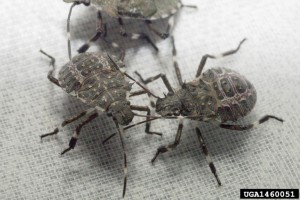What are stink bugs? Where did they come from?
What are Stink Bugs? The Brown Marmorated Stink Bug goes by the Latin name of Halyomorpha haly. Well, here we just call them annoying Stink Bugs. These little pests are native to China, Japan, Korea and Taiwan. They most likely found their way to the States via packing crates. In 1988 the first Brown Marmorated Stink Bug specimen was collected in the United States, in Allentown, PA. Since, the stink bug has become a nuisance in homes and a serious agricultural threat.
Brown Marmorated Stink Bugs can cause serious damage to fruit and vegetable crops. Stink bugs are suckling insects, which means that they use their proboscis, the long tube protruding from the head, to feed on fruits and vegetables. When stink bugs invade your home, you may notice small dimpled areas on exposed fruits, vegetables and houseplants due to this feeding.
Stink bugs survive the winter by taking refuge in your home in the fall. Adults can live from several months to a year. The stink bugs enter s state of hibernation once they come in out of the cold, but the heat of your home may cause them to wake up and move around.
How do stink bugs get in my house?
Stink bugs can find their way through the tiniest of openings. Often they invade under siding and soffits. They even can squeeze their way through spaces in the door and window frames.
Why do Stink Bugs Stink?
Why does a Zebra have stripes? Stink bugs are able to release an odor when they feel threatened. The odor comes from holes in the stink bugs’ abdomen. The pungent odor can emitted when the stink bug is captured, or even when it is crushed.
The good news:
While extremely annoying, stink bugs do not cause much damage inside the home. They lay their eggs outside, and will not breed indoors. Stink bugs do not cause structural damage to the home, and they will not bite people or pets.
Now that you’ve answered the question “What are Stink Bugs?” let’s get on to what you can do about them.
We are bigger, stronger, faster, and, most importantly, smarter than the stink bugs. We can fight them, and take back our homes!
The Bonide Natural Stink Bug Trap
Attract and trap Stink Bugs naturally, while protecting your fruit and vegetable gardens. All natural, non-toxic and odorless.
RESCUE! Non-Toxic Reusable Stink Bug Trap
Lure Stink Bugs into this trap within a 30-foot radius, with an easy disposal.
RESCUE! Non-Toxic Stink Bug Light
Use this special LED attachment with the RESCUE Stink Bug Trap to lure and capture Stink Bugs that are already in your home!





